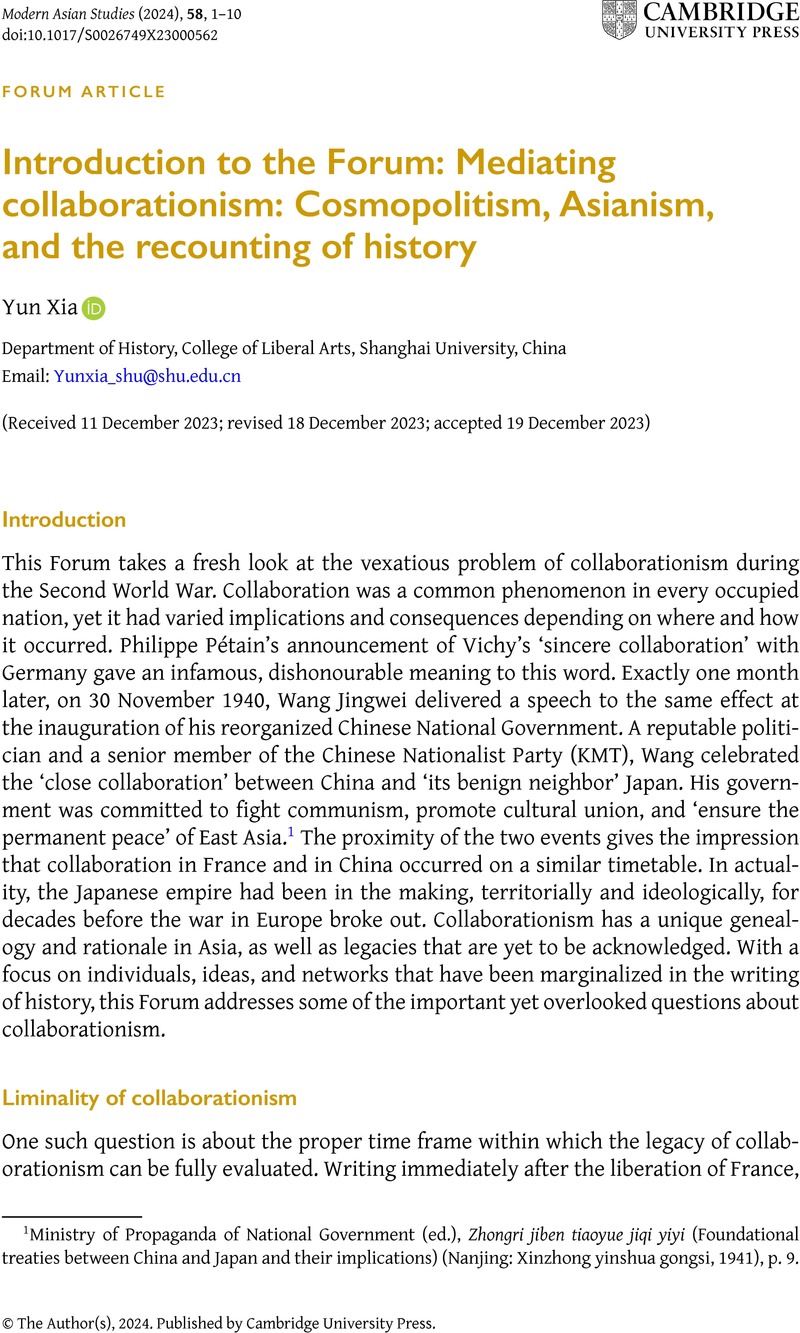No CrossRef data available.
Article contents
Introduction to the Forum: Mediating collaborationism: Cosmopolitism, Asianism, and the recounting of history
Published online by Cambridge University Press: 18 March 2024
Abstract

- Type
- Forum Article
- Information
- Copyright
- © The Author(s), 2024. Published by Cambridge University Press.
References
1 Ministry of Propaganda of National Government (ed.), Zhongri jiben tiaoyue jiqi yiyi (Foundational treaties between China and Japan and their implications) (Nanjing: Xinzhong yinshua gongsi, 1941), p. .Google Scholar
2 Sartre, Jean-Paul, The aftermath of war, (trans) Turner, Chris (London: Seagull Books, 2017), p. .Google Scholar
3 The Republic of China and Japan signed a peace treaty—the Treaty of Taipei—in 1952; two decades later, Japan normalized its relationship with the People’s Republic of China in 1972.
4 See, for instance, Deák, István, Europe on trial: The story of collaboration, resistance and retribution during World War II (Boulder: Westview Press, 2015)Google Scholar; Virgili, Fabrice, Shorn women: Gender and punishment in Liberation France, (trans) Flower, John (Oxford, New York, Munich: Berg Publishers, 2002).Google Scholar
5 Zanasi, Margherita, ‘Globalizing hanjian: The Suzhou Trials and the post-World War II discourse on collaboration’, American Historical Review, vol. 113, no. 3, 2008, p. .CrossRefGoogle Scholar
6 Hirschfeld, Gerhard, ‘Collaboration in Nazi-occupied France: Some introductory remarks’, in Collaboration in France: Politics and culture during the Nazi occupation, 1940–1944, (eds) Hirschfeld, G. and Marsh, P. (Oxford, New York, Munich: Berg Publishers, 1989), p. .Google Scholar
7 Yun Xia discusses the insufficiency of using ‘collaborators’ to translate the Chinese term for traitors, which is hanjian (literally ‘traitors’ to the Han people) in Xia, Yun, Down with traitors: Justice and nationalism in wartime China (Seattle: University of Washington Press, 2017), pp. 7–12Google Scholar. When it comes to collaboration, there is no exact counterpart in Chinese, and the closest one would be tongdi, literally ‘colluding with the enemy’. The Japanese term is 協力, kyoryoku, which carried the same connotation as collaboration, so we retain the use of collaboration when discussing the problem in the Asian-Pacific theatre. Collaboration offers a fairly literal translation for the Japanese term kyōryoku.
8 For instance, Hoffmann calls for looking at collaboration not from the viewpoint of Franco-German relations but from that of Franco-French relations: Hoffmann, Stanley, ‘Collaborationism in France during World War II’, The Journal of Modern History, vol. 40, no. 3, 1968, p. CrossRefGoogle Scholar. Brook, in his analysis of why some local elites collaborated in wartime China, observes that the occupation provided ungratified local elites upward political mobility that was not otherwise available to them: Brook, Timothy, Collaboration: Japanese agents and local elites in wartime China (Cambridge: Harvard University Press, 2007).CrossRefGoogle Scholar
9 Brook, Collaboration; Barrett, David P. and Shyu, Larry N. (eds), Chinese collaboration with Japan,1932–1945: The limits of accommodation (Stanford, CA: Stanford University Press, 2001).Google Scholar
10 Ott, Sandra, Living with the enemy: German occupation, collaboration and justice in the western Pyrenees, 1940–1948 (Cambridge: Cambridge University Press, 2017).CrossRefGoogle Scholar
11 Sartre, The aftermath of war, p. 42.
12 Chihyun Chang and Chiu-Ya Kao, ‘Cosmopolitan collaboration and wartime collaborationism: The Chinese Maritime Customs Service and its staff, 1932–1941’, in this Forum.
13 Xia, Down with traitors; Xia, Yun, ‘Traitors in limbo: Chinese trials of White Russian spies, 1937–1948’, Nationalities Papers, vol. 49, no. 6, 2021, pp. 1096–1112.CrossRefGoogle Scholar
14 Kalyvas, Stathis N., ‘Collaboration in comparative perspective’, European Review of History, vol. 15, no. 2, 2008, pp. 109–111.CrossRefGoogle Scholar
15 Keith, Charles, ‘Vietnamese collaborationism in Vichy France’, Journal of Asian Studies, vol. 76, no. 4, 2017, pp. 987–1008CrossRefGoogle Scholar; Treat, John, ‘Choosing to collaborate: Yi Kwang-su and the moral subject in colonial Korea’, Journal of Asian Studies, vol. 71, no. 1, 2012, pp. 81–102.CrossRefGoogle Scholar
16 Hoffmann, ‘Collaborationism in France during World War II’, p. 375.
17 Kalyvas, ‘Collaboration in comparative perspective’.
18 These five regimes were the Nationalist government in Chongqing (the Chinese Communist Party also belonged to this group as it formed the second United Front with the Nationalist Party), the Reorganized National government in Nanjing, the Northern Political Council, the Mongolia-Xinjiang Joint Government, and Manchukuo.
19 Taylor, Jeremy, ‘Cartoons and collaboration in wartime China: The mobilization of Chinese cartoonists under Japanese occupation’, Modern China, vol. 41, no. 4, 2015, p. .CrossRefGoogle Scholar
20 For the evolution of Pan-Asianism, see Szpilman, Christopher W. A. and Saaler, Sven, Pan-Asianism: A documentary history (New York: Rowman and Littlefield Publishers, 2011)Google Scholar; Yellen, Jeremy A., The Greater East Asia Co-Prosperity Sphere: When total empire met total war (Ithaca: Cornell University Press, 2022).Google Scholar
21 Hotta, Eri, Pan-Asianism and Japan’s war 1931–1945 (New York: Palgrave Macmillan, 2007), p. .CrossRefGoogle Scholar
22 Sang-jung, Kang, Dariben: Manzhou diguo de yichan (The great Japanese empire: The Manchurian legacy) (Taipei: Baqi wenhua chubanshe, 2018).Google Scholar
23 Yoshihiko Honda, ‘Zhusu Dongjing Taipei duanjiao weiji, Manzhou renmai wankuanglan Mixin’, Yazhou zhoukan 30 (2020), available at https://www.yzzk.com/article/details/%E6%AD%B7%E5%8F%B2/2020-30/1595476619449/%E8%BF%BD%E6%BA%AF%E6%9D%B1%E4%BA%AC%E5%8F%B0%E5%8C%97%E6%96%B7%E4%BA%A4%E5%8D%B1%E6%A9%9F%E3%80%80%E6%BB%BF%E6%B4%B2%E4%BA%BA%E8%84%88%E6%8C%BD%E7%8B%82%E7%80%BE%E7%A7%98%E8%BE%9B, [accessed 31 January 2024].
24 See Miller, David, ‘Cosmopolitanism: A critique’, Critical Review of International Social and Political Philosophy, vol. 5, no. 3, 2003, pp. 80–85CrossRefGoogle Scholar; Anthony Appiah, Kwame, Cosmopolitanism: Ethics in a world of strangers (New York: W. W. Norton and Company, 2007).Google Scholar
25 Reed, Charles, Royal tourists, colonial subjects and the making of a British world, 1860–1911 (Manchester: Manchester University Press, 2016), p. .CrossRefGoogle Scholar
26 See, for instance, Bickers, Robert, Britain in China (Manchester: Manchester University Press, 1999)Google Scholar; Bickers, R., Empire made me: An English man adrift in Shanghai (New York: Columbia University Press, 2004)Google Scholar; Wasserstein, Bernard, Secret War in Shanghai (Boston: Houghton Mifflin Harcourt, 1999).Google Scholar
27 Overy, Richard, Blood and ruins: The Great Imperial War, 1931–1945 (London: Penguin Books, 2021)Google Scholar; Rana Mitter, ‘Truly global view of World War II’, The Critic, October 2021, available at https://thecritic.co.uk/issues/october-2021/truly-global-view-of-world-war-ii/, [accessed 31 January 2024].
28 Zanasi, ‘Globalizing hanjian’, pp. 731–751.
29 Yong, Liu and Yi, Li (eds), Zhongguo xiandai wenxue biannianshi: 1895–1949 (A chronological history of modern Chinese literature) (Beijing: Wenhua yishu chubanshe, 2017), vol. 5, pp. 6–7.Google Scholar
30 Sartre, The aftermath of war, p. 9.





